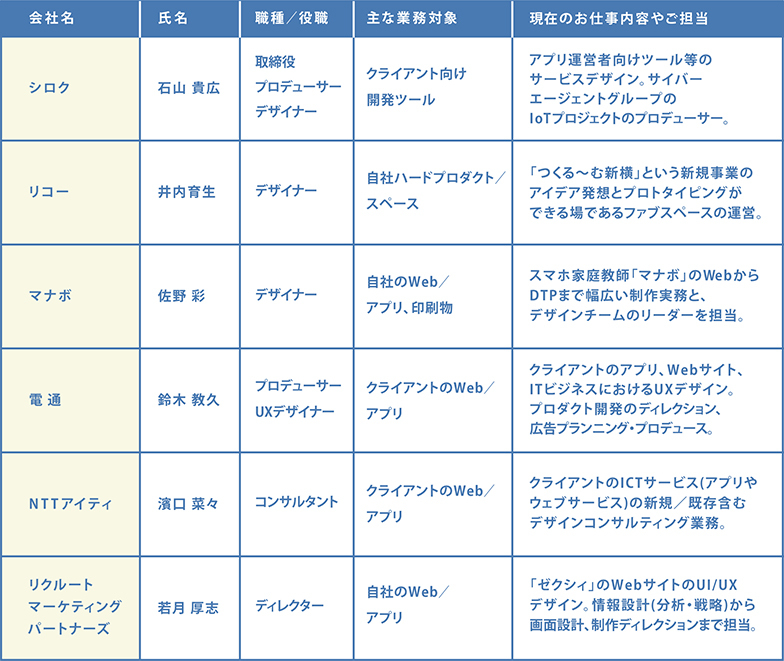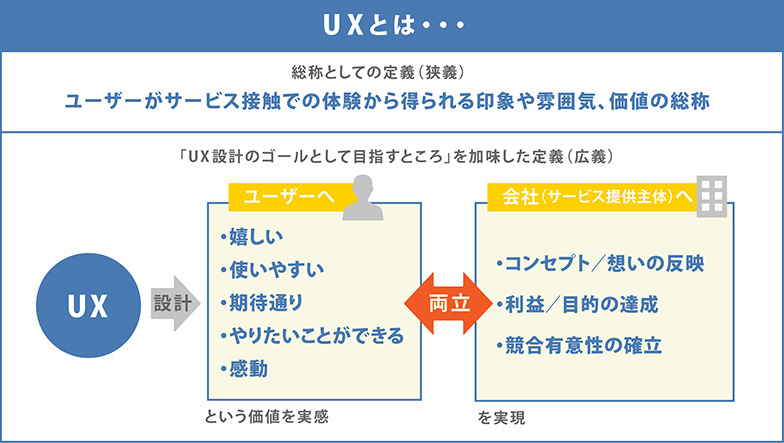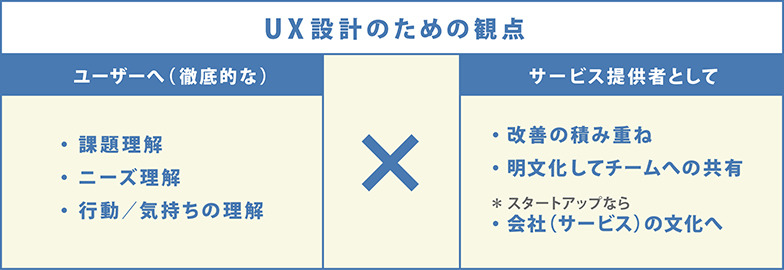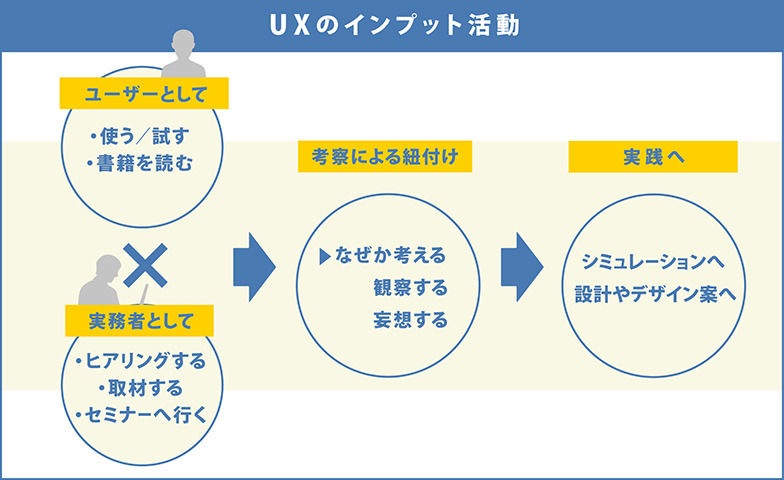What is UX? We asked people actively working in the field (Part 2)
This is the second part of a column on UX, one of the key themes for web/apps. In the first part, we gathered opinions from professionals active in the field regarding the meaning of UX.
[Reprint] To everyone who participated in the survey

[Repost] The four questions we asked
・How would you explain "What is UX (to you)?" if asked?
・Key points you prioritize when considering UX
・Symbolic experiences where you consciously considered UX (if applicable)
・How do you learn about/gain input on UX?
We sent these four questions via email. We will introduce your perspectives on UX and design thinking in this first part, and your past experiences and insights in the second part.
*We have selected approximately four responses.
*The order of responses is random.
*Occasionally, I personally found a response moving or relatable, leading to a longer review—please forgive me for that.
[Reprinted] What is UX?

We also asked about design considerations and extracted key points. This reaffirmed how UX design is an extremely important perspective within corporate business activities.
[Repost] Perspectives for UX Design

*Actual responses areinPart 1
In the second part, we asked about two points: symbolic events that made them think about UX and daily inputs. We then delved deeper into the opportunities that led them to work in UX and their methods for learning UX.
Question 3: What symbolic events made you consciously aware of UX?
I strongly sensed that experiences in daily life and work where the power and usefulness of usability were felt directly led to their current work.
Shiroku Ishiyama
"I feel that changes in the devices used by the masses almost always precede UX transformations. Starting with Flash, and now working in the interaction space with tools like Processing and Canvas, changes in the interfaces I interact with daily leave a strong impression. Major examples include the rise of feature phones, the introduction of touchscreens with the iPhone, the emergence of NUI through devices like LeapMotion and Kinect, and VR. Regardless of whether they become mainstream, I actively seek out these experiences to gain firsthand knowledge."
Practical experience and opportunities to witness technological evolution seem to be strong catalysts.
In my current role, I frequently encounter new communication technologies like e-books, healthcare, image recognition, and growth hacking tools. Each time, I'm amazed by prototypes featuring fresh UX designs.
Manabo Sano
"It started when I was designing websites at a service operating company and realized there was no one internally capable of managing usability. Back then, the production environment meant the overall design framework was decided upstream based on functionality and desired outcomes. Designers would then follow the given requirements, make minor tweaks, and hand it off to engineers... that was the flow. I was struggling with what truly constituted good design for users, beyond just creating visually appealing, pretty screens.
Around that time, I learned about the Information Design Forum, a UX-focused study group in the IT industry. Since then, I've actively participated in these meetings. Especially back then, when the term 'UX' wasn't common and information was scarce, meeting fellow UX practitioners with similar goals, all working at companies running web services, was a huge asset.
However, despite my desire to prioritize UX, it proved extremely difficult to share and implement these ideas within teams running live services that were already generating steady operating profits.
I believe this applies to almost everyone: people who have personally used a service (whether it's a taxi, a train, or Google search) value the experience that service provides. Nevertheless, I think the main reason was that within the company, people couldn't grasp the need to recognize whether the user experience of the services we were developing needed improvement, nor could they find convincing reasons to allocate resources towards enhancing that experience.
Designers creating the interfaces users directly interact with inherently means they work while experiencing the service vicariously as users themselves.
Of course, engineers, directors, and salespeople are also in positions close to the user, but I believe designers empathize with users the most.
In my current role, app development is the main focus, so I believe user experience should be the top priority. Specifically, we discuss UI as a whole team and share usability test results.
Mr. Sano mentioned that his previous experience in web design was significant.
When he previously wrote a series for Growth Hack Japan, the challenge of how difficult it is to discuss UX design was also raised. How to create an environment where the team can work on this together, or where everyone consciously prioritizes and values it, is also very important.
Additionally, Dentsu Inc.'s Suzuki mentioned that experiences in daily life and personal activities left a strong impression.
This connects to the input methods section later, but this sensitivity to absorb insights from daily experiences is also crucial for those working in UX.
Dentsu Inc. Suzuki
"I'm independently developing an app called 'Werewolf Game: Nightmare Prison'. It has now surpassed 3.5 million downloads and has held the number one spot in the educational games category for about three years. How can a single person beat games from major corporations? UX design provided the key insight. While the game is gaining popularity recently due to TV shows and movies, it started from a state of almost zero recognition domestically. To reach this point, I implemented various UX design strategies.
One key discovery was that doing the exact opposite of what typical companies do actually enhances competitive advantage. For example, while the app has banner ad space, I've never profited from these ad slots. Instead, I've featured—free of charge—apps that are competitors, organizations supporting Werewolf games, and individuals involved in disaster volunteer work—anyone I wanted to support. This non-profit-driven approach is a crucial part of the app's UX, and I believe it has attracted a loyal fanbase as a result. ”
Question 4: How do you learn/gather input about UX?
Finally, we asked about input and learning methods, including those outside of work. Many actively try out services themselves.
Ricoh, Mr. Inai
"I try new products and services as soon as possible. I also keep in mind things that bother me or feel good in my daily life. For example, when paying with Suica at a convenience store register, the operation differs by chain, and the impression you get is different. I think about which stores feel good and which feel bad, and why. I apply these observations to simulate themes we consider at work."
I believe it's especially crucial, within our daily service interactions, not just to experience them but to actively rethink their value.
Dentsu Inc., Suzuki
"Much of the UX I handle aims to pursue monetary profit, but in terms of learning, I take the opposite approach. That is, finding value I would want to continue experiencing even if I gained no money whatsoever is my UX learning. What's essential for this, above all, is research and firsthand experience. Real experience doesn't end with merely 'knowing'. It involves giving that experience personal 'meaning'. This is simultaneously choosing one's own way of life. While feeling responsible for the impact my UX design brings to society, I struggle, choose, and decide within deep, swamp-like thoughts. It is through this process that I see the form of 'UX' I should pursue. This entire sequence of actions is my input."
Suzuki's consideration of this meaning-making at the level of social responsibility is particularly impressive.
For example, every other week, I register and use all the top-ranked smartphone apps and competing services.
I immediately capture any UI that impresses me and save it to my camera roll. I've been doing this consistently for about two years now. Unfortunately, when I tell friends about it or show them my camera folder, they tend to back away (sob). But sometimes, those design concepts come to life in UI ideas. ( See this article where I previously organized functions from social game UIs that seemed usable in non-game apps)
Recruit Marketing Partners, Mr. Wakatsuki
"The key is to become a user of various products and services yourself. While my work naturally leans toward online domains, I make a point to engage with products and services in the physical world too. For example, I wander around electronics stores to try out new products, or visit trendy new concept stores in person. By personally experiencing every touchpoint—advertising, branding, websites, trials, after-sales service—I gather insights for UX design."
I completely agree that actually going out for interviews in real work is crucial. Mr. Hamaguchi mentioned he combines learning from seminars and books with the kind of input gained through everyday observations like those mentioned above.
NTT IT's Mr. Hamaguchi
"There's no single right answer, so I believe in diving in headfirst, doing things as I see fit, and learning and growing from experience. If I feel it's necessary, I'll read specialized books or attend seminars, but rather than applying what I learn directly, I store it as knowledge in my mind. I retrieve it as needed, customize it, and use it. Also, when thinking about good UX, I semi-unconsciously collect hints or exemplary UX cases in my daily life. Even just riding the train, observing the actions of the person sitting across from me, the hanging advertisements, or the in-train announcements sparks many insights and questions. I enjoy speculating about why things are done that way."
Mr. Sano from Manabo has provided specific book titles.
Manabo's Sano
I strive to stay updated on the latest information through books, workshops, and research groups on Facebook. UX is just a concept; without the concrete HOW—repeatedly hypothesizing, testing, and implementing user experiences—service improvements won't work.
Among these, I recommend the following as introductory books: "Experience Vision: A Vision-Proposal Design Method for Creating Delightful Experiences by Focusing on Users" ( Maruzen Publishing ) and "Information Design Classroom: Changing Work, Changing Society – Future Design Approaches and Methods" ( Maruzen ).
"Usability Engineering (2nd Edition): Research, Design, and Evaluation Methods for User Experience" ( Ohmsha ) clearly explains concrete methods based on deep experience; I refer back to it repeatedly when I'm unsure.
The motivations of active practitioners and UX learning activities
I'd like to summarize UX input activities.

What impressed me was how they smoothly connect the value gained from daily life, service experiences, and learning to their own design work. In an era where designing user experiences is crucial, I believe such observational skills and the ability to incorporate diverse perspectives are key to progress.
Even in advertising work, I often hear colleagues say things like "experiencing things firsthand, even if I'm not personally interested," or "putting myself in the customer's shoes" serve as input activities, leading to better advertising planning and understanding the consumer perspective. This might be similar.
What did you think? This was written in two parts, Part 1 and Part 2. Thank you to everyone who kindly provided comments despite the sudden request. I'd like to express my gratitude once again.
Next time, I'll introduce a case study where growth hacking and service design know-how cultivated in web/app environments were directly applied to real-world services.
Was this article helpful?
Newsletter registration is here
We select and publish important news every day
For inquiries about this article
Back Numbers
Author

Tomohiro Katayama
Dentsu Inc.
Since graduate school, I have operated web services and sold the company. After joining the company, I have consistently been assigned to departments responsible for new business and product development. In new ventures, I have designed, launched, and grown numerous apps and web services for our company, clients, and media companies. In product development, I primarily focused on transforming cutting-edge digital technologies and methodologies—such as facial recognition, BI tools, MA, digital healthcare, blockchain, growth hacking, and open innovation—into solutions for advertising-adjacent fields where their application was anticipated.

